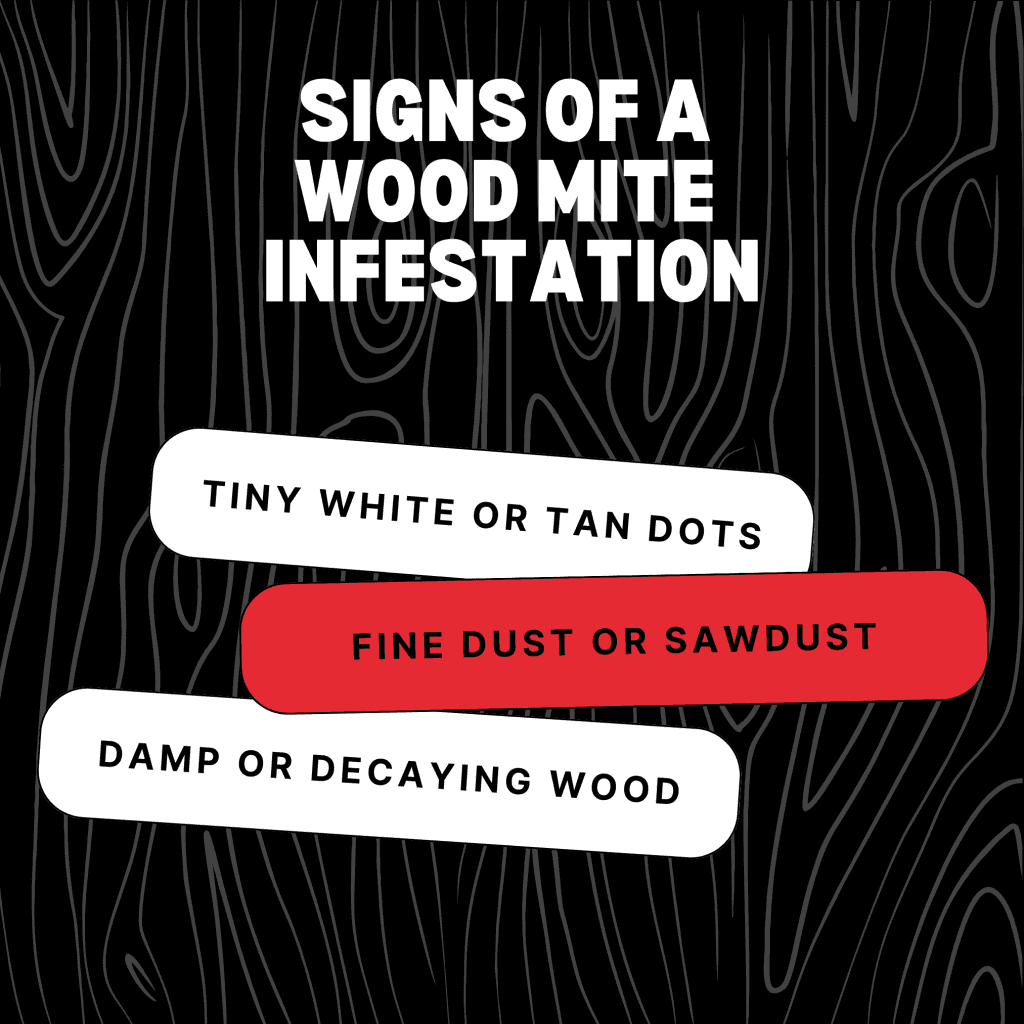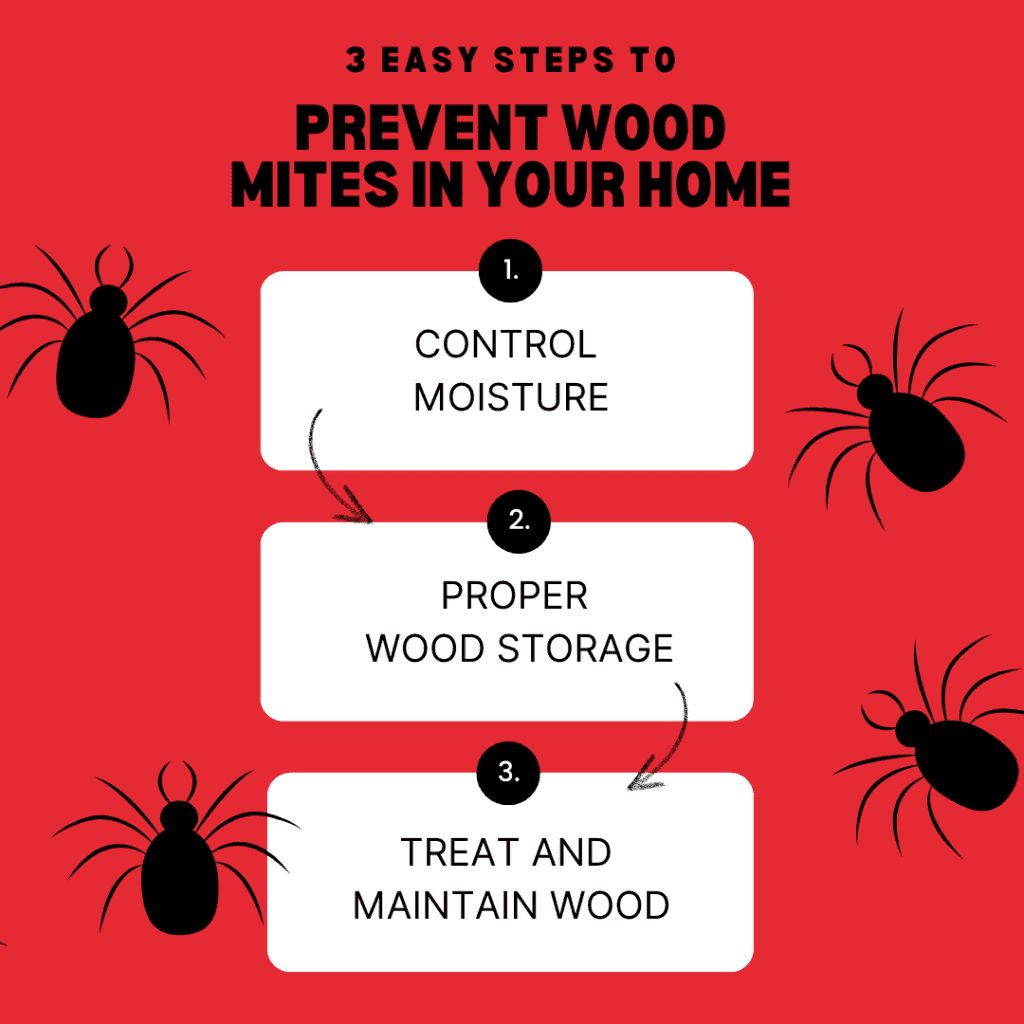Wood mites might not be as well-known as termites, but they can still be a problem if they find their way into your home. These tiny pests often live in damp, decaying wood, feeding off fungi or mold. While they don’t cause the same structural damage as termites, their presence is a sign that your home could have moisture issues. In this blog, we’ll explain what wood mites are, how to recognize them, and, most importantly, how to prevent and eliminate them to protect your home.
What Are Wood Mites?
Wood mites are tiny insects that typically thrive in damp and decaying wood. They are nearly invisible to the naked eye but can sometimes appear as tiny white, tan, or light brown specks on wood surfaces. Unlike termites, wood mites don’t eat or destroy the wood itself; instead, they feed on fungi, mold, or other organic material present on the wood’s surface.
Though they aren’t harmful to humans or pets, they can still be a nuisance. In large numbers, they can spread across your home and furniture, especially if the conditions are right. Their presence is often an indicator of underlying moisture problems, which could lead to more severe issues if ignored.
Are Wood Mites Dangerous?
Wood mites themselves are not dangerous. They don’t bite or sting, and they don’t spread diseases. However, their presence can be a sign of bigger problems in your home, such as excess moisture, which can lead to mold growth or attract other more harmful pests, like termites or carpenter ants.
While wood mites may not directly harm your home, they can infest furniture, wooden floors, or other wood materials in your living space. Left untreated, they can cause the wood to become a breeding ground for fungi or mold, which could cause damage over time. If you notice signs of them, it’s essential to address them quickly to prevent other pests from taking advantage of the same conditions.
Signs of a Wood Mite Infestation

Wood mites are very small, but there are some clear signs that they may be present in your home. Here’s what to look for:
- Tiny White or Tan Dots: Since they are so small, they can often be mistaken for dust. If you see small, moving specks on wood surfaces, particularly around furniture or wood structures, this could be an indication of mites.
- Fine Dust or Sawdust: One of the more telltale signs of an infestation is a fine layer of dust or sawdust around wood surfaces. This debris isn’t caused by the mites themselves, but by the decaying wood they’re living in, which can eventually weaken the wood.
- Damp or Decaying Wood: They thrive in moisture-rich environments. If you have any damp, decaying wood in your home—whether in furniture, walls or even floorboards—it could attract mites. Pay close attention to areas where water damage or leaks have occurred.
If you notice any of these signs, it’s essential to take action immediately. While wood mites may not destroy your home, they can create conditions that make it easier for more destructive pests to move in.
What Causes Wood Mite Infestations?
Wood mites are primarily drawn to areas with high moisture content and decaying wood. Here are some common reasons why they might infest your home:
- Excess Moisture: The primary factor leading to wood mite infestations is moisture. Leaky pipes, high humidity, or areas of standing water create ideal conditions for mites to thrive. Homes with poor ventilation or high humidity in places like basements or attics are especially vulnerable.
- Damp Wood: Untreated or water-damaged wood is highly attractive to mites. Firewood stored indoors or wooden items exposed to damp outdoor conditions can bring mites inside. Mites often come from outdoor sources like woodpiles, mulch, or decaying trees near your home.
- Organic Decay: Mites feed on the organic matter found in decaying wood. If there are areas in your home where wood is rotting or breaking down, such as under your floors, within your walls, or even in old furniture, this can attract mites.
How to Prevent Wood Mites in Your Home

Prevention is the key to avoiding wood mites and the problems they can cause. Here are some simple yet effective ways to keep them out:
- Control Moisture: The most important thing you can do is control the moisture in your home. Fix any leaks promptly, use dehumidifiers in damp areas, and ensure your home has proper ventilation. Drying out your home makes it much harder for them to survive.
- Proper Wood Storage: If you have firewood or any untreated wood, store it outdoors and away from your home’s foundation. Mites and other pests often hitch a ride into your house via wood brought inside, so make sure it’s dry and pest-free before bringing it in.
- Treat and Maintain Wood: Regularly maintain wooden surfaces, especially those exposed to moisture. Sealing and treating wood furniture, decks, or other structures will prevent decay and discourage mites from taking up residence.
How to Get Rid of Wood Mites
If you discover a wood mite infestation in your home, there are several steps you can take to remove it:
- DIY Methods: Start by cleaning affected areas thoroughly. Use a damp cloth to wipe away any mites you see and vacuum the surrounding area. Keep the area as dry as possible using dehumidifiers or fans. If the infestation is confined to a small piece of wood, consider removing and discarding it. If the infestation is widespread, more extensive measures may be needed.
- Professional Pest Control: If DIY methods don’t work, or if the infestation seems to be getting worse, it’s time to call in a professional pest control service. They’ll be able to assess the situation and use safe, effective treatments to eliminate the mites. They’ll also help identify the underlying cause, whether it’s moisture, decaying wood, or another issue
Conclusion
Wood mites may not cause the same level of damage as termites, but their presence is often a warning sign that your home has moisture or wood decay issues. Preventing them starts with controlling moisture, maintaining wood surfaces, and acting quickly if you notice an infestation. While some DIY methods can help, hiring a professional pest control company ensures a more thorough and long-lasting solution. Professionals can provide effective treatments, identify the root causes, and offer long-term protection for your home.
Don’t let a small problem turn into a bigger one. If you suspect wood mites or other pests in your home, contact us today for a thorough inspection and expert treatment. We’ll make sure your home is pest-free and protected for the future.
The post Understanding and Preventing Wood Mites appeared first on AAA Pest Control | South Florida's Finest Pest Control Services.

